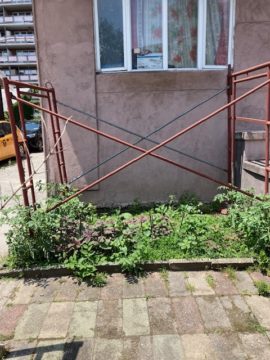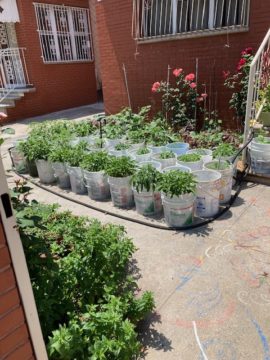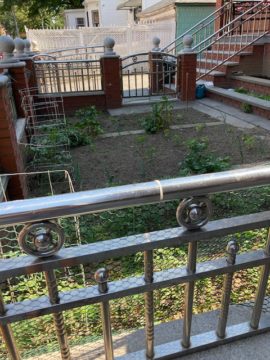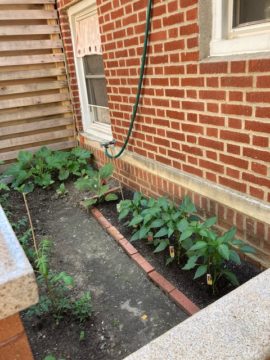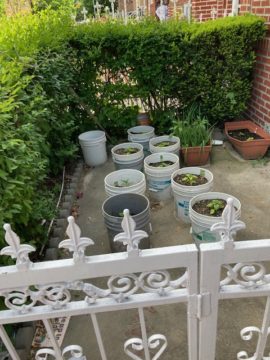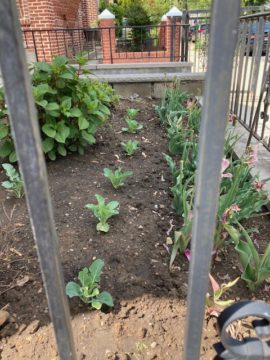by Angela Starita
When I moved into my new neighborhood, I was anxious to the point of nausea. Even today, the soap my husband and I used to clean the kitchen when we first arrived induces a nervous sadness, the feeling of a no-turning-back crisis. But this was one I’d brought upon myself. We’d moved from a wonderful 2-bedroom apartment overlooking the campus of an art school in the now idealized landscape of Brownstone Brooklyn, and that treasure in the currency of New York City real estate, just two blocks from the subway. But I wanted more space and a chance to garden. I got that in a house in Kensington, about five miles south of my old place, but culturally at a complete remove. Kensington is a world of immigrants and Hasidic Jews, row houses and dozens of brick apartment buildings along a road that runs straight to Coney Island. That last, Ocean Parkway, was the idea of the great Olmsted and Vaux of Central Park fame, and it had been an esteemed address at one time. (While I suspected this from the architecture of some of the older buildings, my hunch was confirmed when I heard an interview with David Geffen describing his childhood ambition to one day have an apartment on Ocean Parkway. It should be noted, that Geffen said this to demonstrate what a parochial world view he’d had as a young man.) The neighborhood’s eastern boundary, Coney Island Avenue, is overrun with car repair shops almost as desolate as F. Scott Fitzgerald’s Valley of the Ashes.
In the first two years in Kensington, I spent much of my weekends in the back and front yards, trying to create a breezy, wild-looking garden in the front, a tidy oasis of fruit trees and vegetable plots in the back. My gardens have been various forms of failure with a few moments of triumph. Maybe dissatisfaction is the natural state for a gardener, and for the most part, I’m at ease with work that is in a constant state of revision. The act itself—trying to tame a set of living things subject to factors comically out of any person’s control—requires a 12-step prayer for calm and courage. And despite its vast stores of knowledge, the internet provides little solace since plant diseases—much like human ones—present themselves in unimaginatively limited ways: brown leaves, sagging posture, a disinclination to bear flower or fruit. The constant nagging, low-level irritation is aggravated by my forays into the adjoining neighborhood, Ditmas Park. Just three blocks east and separated by a north-south avenue of car repair shops and takeout restaurants, Ditmas Park boasts some of the borough’s most beautiful homes, ones not at all associated with Brooklyn, but straight out of Vincente Minelli’s “Meet Me in St. Louis.” Most of them were built by developers in the 1920s to create just that impression: turrets and dormer windows, stained glass, and wrap-around porches. Victorian, Queen Anne, Arts and Crafts, Richardsonian, Italianate: there’s no concern for temporal consistency. What they have in common is their massive size, the old trees that line the blocks, and their generously sized plots.
Ditmas Park’s flowers and shrubs were my gardening models, along with the matte pages of David Austin’s specialty rose catalog. But the walk from the grand houses of Ditmas Park to my own neighborhood is as disorienting as it short, like slamming into the grungy Jersey City of my childhood after touring the Lake District. There are no faux stone cottages, but it is equally eclectic. The rhythm of identical brownstones is anathema to Kensington where you’ll find apartment buildings with decrepit entryways or slanted aluminum awnings reminiscent of Miami and capri pants next to an abandoned Victorian or renovated 3-story houses faced in sparkly brick with gold- and silver-colored gates, which I’ve since learned is a status symbol among South Asian families.
My husband and I moved in one August, and I immediately set about ripping up the lawn that the last owner had planted. Mila, the affectless six-year-old next door, voiced her disapproval, but I was determined to undermine any hint of Kensington as suburb. I furiously tugged out the plugs of healthy sod while at night reviewing nursery catalogs and drawing dozens of schemes and charts to ensure that there would always be something blooming from April to September. I was in a hurry to make it all happen; at that point, we didn’t think we’d want to stay in the neighborhood for too many years, so I wanted to maximize my days with a garden while I had one.
While gardening may appear to be an endeavor of solitary toil, I found in it a personal ideal: socializing while working, getting to make all the decisions over my little plots while engaging in countless conversations with passersby. Hazel, my dog, oversaw all this from the porch, barking and rushing to me whenever anyone got too close. Kensington is not beautiful–not its houses or its landscape–but in these hours it was certainly the urban Mayberry I’d hoped for. Joel, who lived next door, would sit in a folding chair on his porch and watch my progress. I met down-the-street neighbors who introduced themselves and their dogs. Some told me about all the construction done by the man I’d bought the house from, his constant drunkenness, and incendiary anger. Larisa, a talkative musician from Ukraine who recorded paeans to Rustik, her perky dachshund, imagined that my furious gardening was done in an attempt to compete with a yard in the next block. I met the extraordinary Shraggy, a boy from one of two Orthodox Jewish families on the block. He was only six that summer, but his benevolent command of his younger brothers and playmates on the block made him seem much older. He loved to help me plant flower seeds, but most others who walked by were startled by my greetings. A youngish woman called me a stupid bitch because I never leashed Hazel, who had run off the porch to growl at her dog. I got to know the schedule of Donald, a recovering addict and neighborhood old-timer, who lived in a basement apartment two doors up the street. Whatever compulsions drove him to meth had, by the time I met him, been safely funneled to the obsessive sweeping and raking of leaves from his landlady’s driveway. He was furious at the city and the school across the street and anyone else who had ever planted a tree on the block.
Of these regulars, I most looked forward to a Bangladeshi couple that passed with their tiny daughter, a beautiful and exuberant girl named Tasnim. None of them spoke English, but the father, wearing two hearing aids, smiled whenever the girl ran to hug me. I learned that they had moved into the neighborhood just a few months before I had and lived in the top floor apartment of a decrepit house where another young acquaintance, Rakib, lived in the basement. During my first winter in Kensington, I’d run into Rakib, who’d arrived in New York from Bangladesh that year, walking around at night without no jacket. When I asked why, he explained that his evening walks were an exercise in literal and metaphoric acclimation, toughening up for this new, colder environment.
Rakib, it turned out, came from the same region as the little girl, Sandwip, an island in the Bay of Bengal. I eventually learned that the neighborhood had many residents from Sandwip, so many that an annual picnic for them attracts hundreds to upstate New York for a day outdoors. When Tasnim and her older sisters, Ayesha and Sharmin, showed me photos of the festivities, they declared that the upstate town looked like Bangladesh. By then, I was used to this observation: on the occasions when I took them to Prospect Park, a mile north from our block, they’d say the same thing: just like Bangladesh.
In Sandwip, they had lived on a farm with cows and chickens. Though their farm is still there, I often wonder about the specific circumstances of their emigration. I know the island increasingly loses land to flooding. Their father, Mohammed, is a farmer and would point to plants in my front yard and nod his approval. When I’d ask him advice, he’d say something in Bengali, and because his hearing is so impaired, I’m not sure I’d have understood even if I spoke the language since his speech alternates between muffled and piercing. But it didn’t matter since my questions were really meant as a kind of greeting and an acknowledgement of his expertise so wasted here in Brooklyn.
The family lived on the top floor of a 3-story building and Tasnim once had hopes of planting flowers in the empty square of dirt outside her house. But the sandy quality of the soil along with a tall maple tree blocking the sun made the endeavor impossible, and she soon abandoned it. But I began to realize that all over the neighborhood, people had found ways to build gardens whether they had yards of their own or not. And none of these farmers waste their improvised lots on the lilies and butterfly bushes and salvia I’d planted. They grow food—eggplants, bitter melons, figs, cucumbers, zucchini. The favored medium for the landless is plastic buckets that once held joint compound. These are filled with soil, then carefully staked, and arranged along 1-foot wide dead spaces between apartment buildings or on concrete porches. Those with front yards plant rows of peppers and squash directly into the dirt—I’m too paranoid about dogs and people and lead content to take such a leap—then cover the ground with sheets to keep down weeds.
My walks through the neighborhood took on a purpose, and I began seeing these farms all over Kensington, in yards with rusted appliances or scaffolding, in driveways, against the south-facing walls of apartment buildings on Ocean Parkway. I started to realize that for many of my neighbors, Kensington wasn’t a first step to the suburbs as I’d assumed but served as a conduit, however flawed, to the rural plots they’d lost to floods or had never had enough money to own in the first place.
